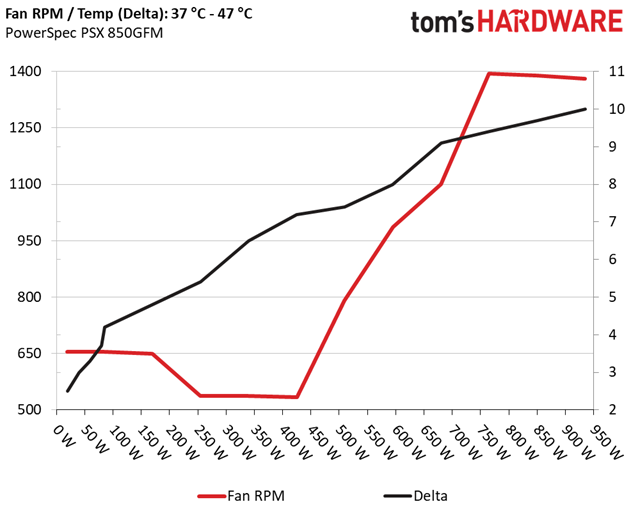PowerSpec PSX 850GFM PSU Review: Micro Center's House Brand Scores A Hit
Why you can trust Tom's Hardware
Efficiency, Temperature & Noise
Efficiency
Our efficiency testing procedure is detailed here.
Using results from the previous page, we plotted a chart showing the PSX 850GFM’s efficiency at low loads, and loads from 10 to 110 percent of its maximum-rated capacity.


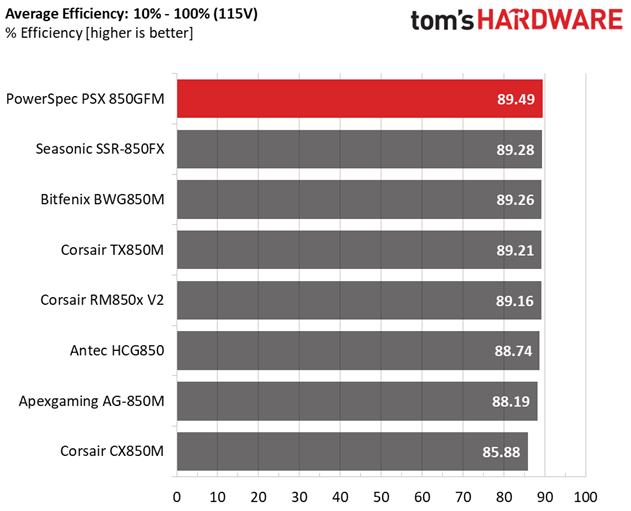
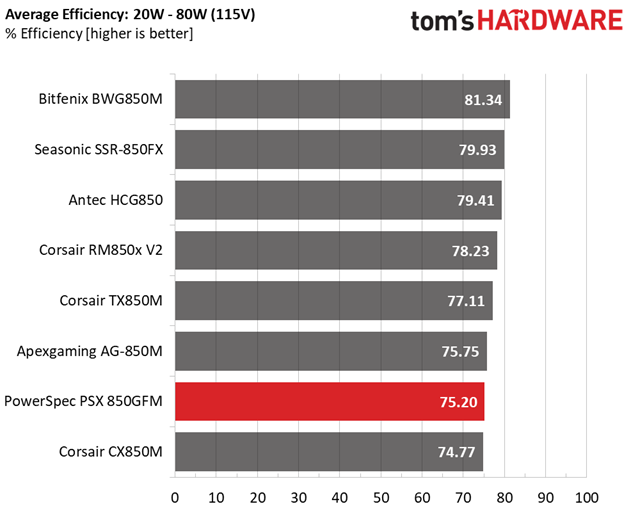
This platform is highly efficient under normal loads. It's not as efficient under light loads, though. The PSX 850GFM posted similar results as Corsair's CX850M, a lower-rated power supply.
Efficiency At Low Loads
In the following tests, we measure the PSX 850GFM's efficiency at loads significantly lower than 10 percent of its maximum capacity (the lowest load the 80 PLUS standard measures). The loads we dial are 20, 40, 60, and 80W. This is important for representing when a PC is idle, with power-saving features turned on.
| Test # | 12V | 5V | 3.3V | 5VSB | DC/AC (Watts) | Efficiency | Fan Speed | PSU Noise | PF/AC Volts |
|---|---|---|---|---|---|---|---|---|---|
| 1 | 1.196A | 0.494A | 0.473A | 0.198A | 19.548 | 52.751% | 655 RPM | 15.4 dB(A) | 0.901 |
| 12.083V | 5.053V | 3.385V | 5.045V | 37.057 | 115.32V | ||||
| 2 | 2.463A | 0.991A | 0.976A | 0.398A | 40.001 | 78.609% | 655 RPM | 15.4 dB(A) | 0.934 |
| 12.056V | 5.049V | 3.381V | 5.033V | 50.886 | 115.31V | ||||
| 3 | 3.658A | 1.486A | 1.450A | 5.022A | 59.470 | 83.650% | 655 RPM | 15.4 dB(A) | 0.959 |
| 12.048V | 5.046V | 3.377V | 5.022V | 71.094 | 115.29V | ||||
| 4 | 4.919A | 1.983A | 1.957A | 0.799A | 79.855 | 85.770% | 650 RPM | 15.3 dB(A) | 0.969 |
| 12.045V | 5.043V | 3.373V | 5.011V | 93.104 | 115.27V |
With 20W load, the PSX 850GFM's efficiency was very low. It fared better as the load increased. But the first test's results hammered this PSU's overall efficiency score under light loads.
5VSB Efficiency
The ATX specification (revision 1.4), along with CEC, ErP Lot 3 2014 and ErP Lot 6 2010/2013, states that 5VSB standby supply efficiency should be as high as possible, recommending 75 percent or higher with 550mA, 1A, and 1.5A of load. The PSU should also achieve higher than 75% efficiency at 5VSB under full load, or with 3A if its max current output on this rail is higher than 3A.
We take six measurements: one each at 100, 250, 550, 1000, and 1500mA, and one with the full load the 5VSB rail can handle.
Get Tom's Hardware's best news and in-depth reviews, straight to your inbox.
| Test # | 5VSB | DC/AC (Watts) | Efficiency | PF/AC Volts |
|---|---|---|---|---|
| 1 | 0.100A | 0.509 | 73.555% | 0.053 |
| 5.089V | 0.692 | 115.37V | ||
| 2 | 0.250A | 1.271 | 76.520% | 0.119 |
| 5.082V | 1.661 | 115.37V | ||
| 3 | 0.550A | 2.788 | 78.846% | 0.213 |
| 5.069V | 3.536 | 115.37V | ||
| 4 | 1.000A | 5.050 | 79.640% | 0.291 |
| 5.049V | 6.341 | 115.37V | ||
| 5 | 1.500A | 7.541 | 79.664% | 0.335 |
| 5.027V | 9.466 | 115.36V | ||
| 6 | 3.000A | 14.866 | 77.230% | 0.394 |
| 4.955V | 19.249 | 115.35V |
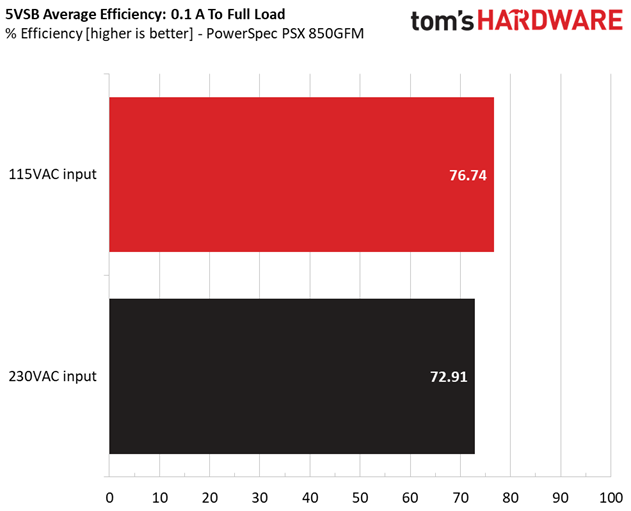
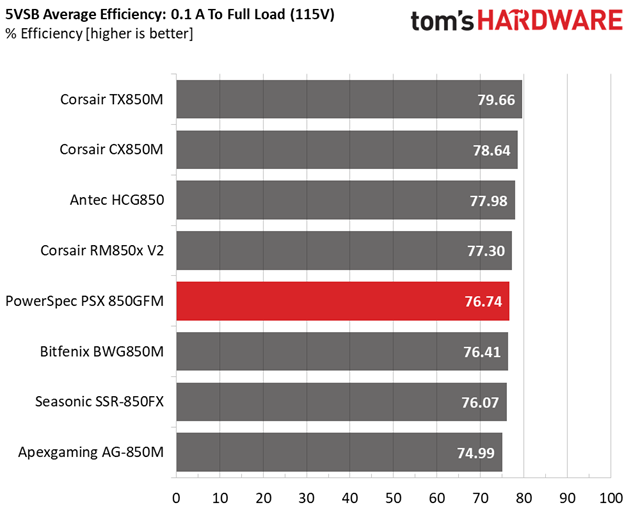
The 5VSB rail yielded satisfactory efficiency results (at least with 115V input).
Power Consumption In Idle And Standby
In the table below, you'll find the power consumption and voltage values of all rails (except -12V) when the PSU is idle (powered on, but without any load on its rails), and the power consumption when the PSU is in standby mode (without any load, at 5VSB).
| Mode | 12V | 5V | 3.3V | 5VSB | Watts | PF/AC Volts |
|---|---|---|---|---|---|---|
| Idle | 12.125V | 5.059V | 3.390V | 5.059V | 8.709 | 0.727 |
| 115.3V | ||||||
| Standby | 0.090 | 0.007 | ||||
| 115.3V |
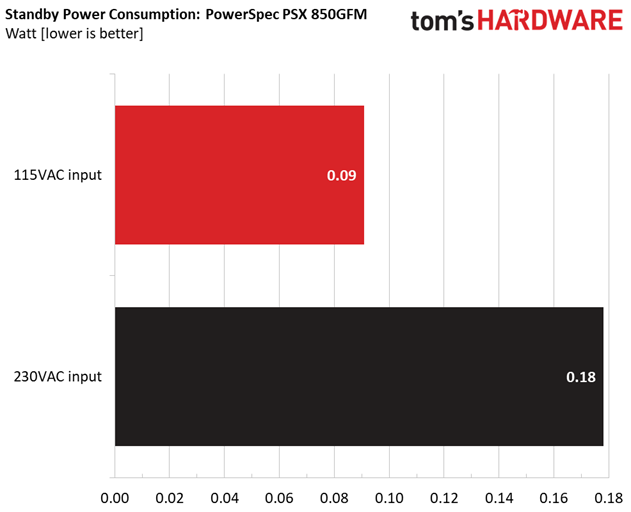
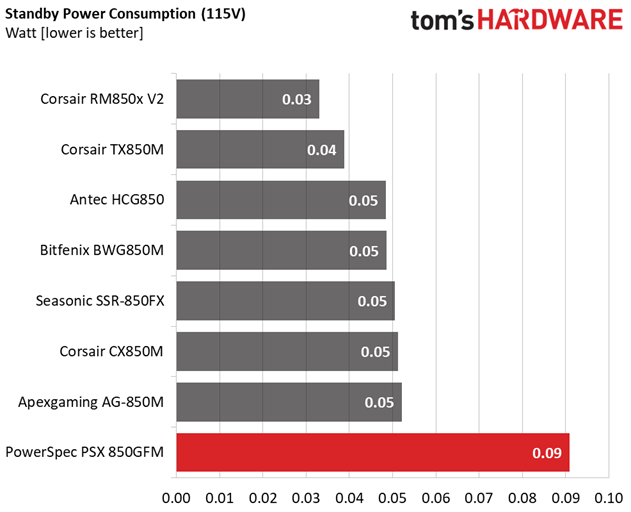
Standby power consumption was higher than we'd like, especially with 230V input.
Fan RPM, Delta Temperature, And Output Noise
Our mixed noise testing is described in detail here.
The first chart below illustrates the cooling fan's speed (in RPM), and the delta between input and output temperature. The results were obtained at 37°C (98.6°F) to 47°C (116.6°F) ambient temperature.
The next chart shows the cooling fan's speed (again, in RPM) and output noise. We measure acoustics from one meter away, inside a hemi-anechoic chamber. Background noise inside the chamber is below 6 dB(A) during testing (it's actually much lower, but our sound meter’s microphone hits its floor), and the results are obtained with the PSU operating at 37°C (98.6°F) to 47°C (116.6°F) ambient temperature.
The following graph illustrates the fan's output noise over the PSU's operating range. The same conditions of the above graph apply to our measurements, though the ambient temperature is between 30°C (86°F) to 32°C (89.6°F).
The PSU's passive mode started at a load level around 350W, which is really weird. Fortunately, the fan started spinning slowly, so its overall noise output wasn't notably affected by the strange behavior.
MORE: Best Power Supplies
MORE: How We Test Power Supplies
MORE: All Power Supply Content
Current page: Efficiency, Temperature & Noise
Prev Page Load Regulation, Hold-Up Time & Inrush Current Next Page Protection Features & DC Power Sequencing
Aris Mpitziopoulos is a contributing editor at Tom's Hardware, covering PSUs.
-
AnimeMania In the video, you should have turned on the PSU and shown all the RGB lighting choices.Reply -
pureblackfire2 I wouldn't consider this even if it's cheap. for non enthusiasts it's far from idiot proof enough to recommend. for power users they'd obviously want something better. meh.Reply -
Rexper Low quality sleeve bearing fan without Over Temperature Protection or Fan Failure Protection? No thanks.Reply
